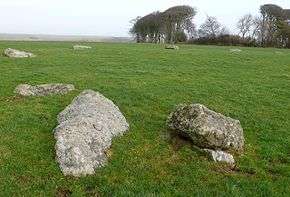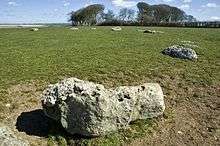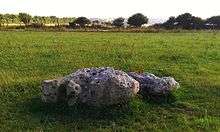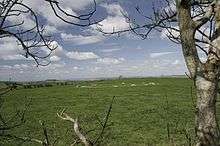Kingston Russell Stone Circle
 View across the western half of the circle | |
 Shown within Dorset | |
| Location | Kingston Russell |
|---|---|
| Coordinates | 50°41′19″N 2°35′56″W / 50.688526°N 2.598998°W |
| Type | Stone circle |
| History | |
| Periods | Neolithic / Bronze Age |
| Site notes | |
| Ownership | English Heritage |
Kingston Russell Stone Circle (grid reference SY57788782), also known as the Gorwell Circle, is a stone circle located between the villages of Abbotsbury and Littlebredy in the south-western English county of Dorset. Archaeologists believe that it was likely erected during the Bronze Age. The Kingston Russell ring is part of a tradition of stone circle construction that spread throughout much of Britain, Ireland, and Brittany during the Late Neolithic and Early Bronze Age, over a period between 3,300 and 900 BCE. The purpose of such monuments is unknown, although archaeologists speculate that they were likely religious sites, with the stones perhaps having supernatural associations for those who built the circles.
A number of these circles were built in the area around modern Dorset, typically being constructed from sarsen stone and being smaller than those found elsewhere. The Kingston Russell ring is the largest of those in Dorset, measuring 91 feet (27.7 metres) in diameter and containing eighteen sarsen stones arranged in an oval shape. The site has not been excavated or been subject to in-depth archaeological investigation.
Location
Positioned at the national grid reference 35770878,[1] Kingston Russell Stone Circle is located on a hilltop overlooking Abbotsbury and the sea.[2] It is positioned on a chalk ridge that is west of Portesham.[3] The site is located on open downland at a height of 620 feet above sea level.[4] The historic house of Kingston Russell is about a mile to the north. The ruined burial chamber known as The Grey Mare and her Colts is a short distance to the southeast.[2]
The site is also known as the Gorwell Circle, a name adopted from Gorwell Farm to the south.[5] It can be approached via a footpath from near to Gorwell Farm.[1] It is most visible when the grass around it is cut short, for the stones are obscured when the grass grows longer.[1]
Context

While the transition from the Early Neolithic to the Late Neolithic—which took place with the transition from the fourth to the third millennium BCE—witnessed much economic and technological continuity, it also saw a considerable change in the style of monuments erected, particularly in southern and eastern England.[6] By 3000 BCE, the long barrows, causewayed enclosures, and cursuses which had predominated in the Early Neolithic had ceased being built, and were instead replaced by circular monuments of various kinds.[6] These include earthen henges, timber circles, and stone circles.[7] These latter circles are found in most areas of Britain where stone is available, with the exception of the island's south-eastern corner.[8] They are most densely concentrated in south-western Britain and on the north-eastern horn of Scotland, near Aberdeen.[8]
These stone circles typically show very little evidence of human visitation during the period immediately following their creation.[9] This suggests that they were not sites used for rituals that left archaeologically visible evidence, and may have been deliberately left as "silent and empty monuments".[10] The archaeologist Mike Parker Pearson suggested that in Neolithic Britain, stone was associated with the dead and wood with the living.[11] Other archaeologists have suggested that the stone might not represent ancestors, but rather other supernatural entities, such as deities.[10]

The area of modern Dorset has only a "thin scatter" of stone circles,[12] with nine possible examples known within its boundaries.[13] The archaeologist John Gale described these as "a small but significant group" of such monuments,[13] and all are located within five miles of the sea.[14] All but one—Rempstone Stone Circle on the Isle of Purbeck—are located on the chalk hills west of Dorchester.[15] The Dorset circles have a simplistic typology, being of comparatively small size, with none exceeding 28 metres in diameter.[16] All are oval in shape, although perhaps have been altered from their original form.[17] Much of this may have been obtained from the Valley of Stones, a location at the foot of Crow Hill near to Littlebredy, which is located within the vicinity of many of these circles.[18] With the exception of the circle at Litton Cheney, none display evidence of any outlying stones or earthworks around the stone circle.[19]
The archaeologists Stuart and Cecily Piggott believed that the circles of Dorset were probably of Bronze Age origin,[4] a view endorsed by Burl, who noted that their distribution did not match that of any known Neolithic sites.[20] It is possible that they were not all constructed around the same date,[21] and the Piggotts suggested that while they may well be Early Bronze Age in date, it is also possible that "their use and possibly their construction may last into the Middle and even into the Late Bronze Age".[4] Their nearest analogies are the circles found on Dartmoor and Exmoor to the west, and the Stanton Drew stone circles to the north.[22] It is also possible that the stone circles were linked to a number of earthen henges erected in Dorset around the same period.[4]
Description

Kingston Russell is the largest surviving stone circle in Dorset,[23] with a diameter of 91 feet (27.7 metres).[24] The stone circle consists of eighteen stones situated on a chalk ridge.[3][25] As of 1939, all the stones were recumbent, although there is a record that in 1815 one stone on the southern side was still standing.[26] The archaeologists Stuart Piggott and Cecily Piggott suggested that while the circle retained its full number of original megaliths, some of them might have been removed from their original positions.[27] It is possible that the ring was graded in height, with the tallest stones being located on the north.[24]
The stones are made of sarsen or conglomerate.[28] Some of the stones are broken, and it is impossible to tell which fragments are bases and which were originally upper parts.[24] The stones vary in size from 2 metres by 0.5 metres to 1 metre by 0.3 metres.[25] The stones are arranged in an oval with a diameter measuring from 24 by 27 metres.[1][2] Many of the stones may not be in their original positions.[25] The longest stones are located at the north of the circle.[14] In 1980, it was stated that a stone was "supposed" to have been added to the circle "in recent years".[24]
In 1815 it was recorded that one stone on the south side was still standing, the rest having fallen by that date.[25] The site is on privately-owned land although is accessible to the public.[1] As of 2003, the site had not been excavated by archaeologists or extensively studied.[1]
References
Footnotes
- 1 2 3 4 5 6 Gale 2003, p. 161.
- 1 2 3 History and Research: Kingston Russell Stone Circle, English Heritage, 26 August 2014
- 1 2 Gale 2003, p. 75.
- 1 2 3 4 Piggott & Piggott 1939, p. 142.
- ↑ Piggott & Piggott 1939, p. 143.
- 1 2 Hutton 2013, p. 81.
- ↑ Hutton 2013, pp. 91–94.
- 1 2 Hutton 2013, p. 94.
- ↑ Hutton 2013, p. 97.
- 1 2 Hutton 2013, p. 98.
- ↑ Hutton 2013, pp. 97–98.
- ↑ Burl 2000, p. 307.
- 1 2 Gale 2003, p. 72.
- 1 2 Burl 2000, p. 308.
- ↑ Piggott & Piggott 1939, p. 138.
- ↑ Piggott & Piggott 1939, p. 139; Burl 2000, p. 308; Gale 2003, p. 72.
- ↑ Burl 2000, p. 308; Gale 2003, p. 72.
- ↑ Burl 2000, p. 308; Gale 2003, pp. 182–183.
- ↑ Piggott & Piggott 1939, p. 139.
- ↑ Burl 2000, p. 310.
- ↑ Piggott & Piggott 1939, p. 141.
- ↑ Piggott & Piggott 1939, p. 140.
- ↑ Gale 2003, pp. 75, 161.
- 1 2 3 4 Thom, Thom & Burl 1980, p. 119.
- 1 2 3 4 Historic England. "Kingston Russell Stone Circle (450256)". PastScape. Retrieved 26 August 2014.
- ↑ Piggott & Piggott 1939, p. 143; Gale 2003, p. 75.
- ↑ Piggott & Piggott 1939, pp. 142, 143.
- ↑ Thom, Thom & Burl 1980, p. 119; Gale 2003, p. 75.
Bibliography
- Burl, Aubrey (2000). The Stone Circles of Britain, Ireland and Brittany. New Haven and London: Yale University Press. ISBN 978-0-300-08347-7.
- Gale, John (2003). Prehistoric Dorset. Stroud: Tempus. ISBN 978-0-7524-2906-9.
- Hutton, Ronald (2013). Pagan Britain. New Haven and London: Yale University Press. ISBN 978-0-300-19771-6.
- Piggott, Stuart; Piggott, C. M. (1939). "Stone and Earth Circles in Dorset". Antiquity. 13 (50). pp. 138–158. doi:10.1017/S0003598X00027861.
- Thom, Alexander; Thom, Archibald Stevenson; Burl, Aubrey (1980). Megalithic Rings: Plans and Data for 229 Monuments in Britain. BAR British Series 81. Oxford: British Archaeological Reports. ISBN 0-86054-094-4.
External links
![]() Media related to Kingston Russell Stone Circle at Wikimedia Commons
Media related to Kingston Russell Stone Circle at Wikimedia Commons
- Kingston Russell Stone Circle, English Heritage